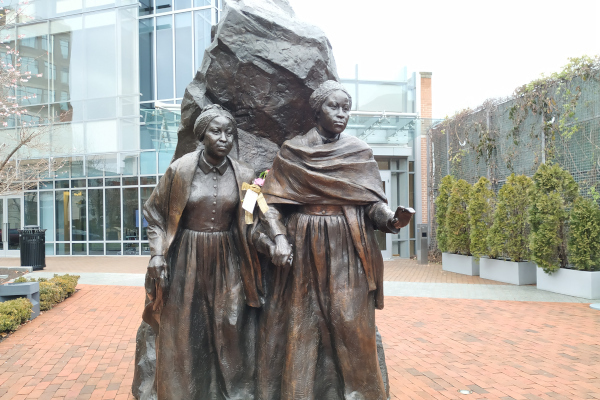In the seventeenth century, all slave states passed laws declaring that the children of an enslaved mother inherited her legal status. Eventually the children of any free person and enslaved person were declared slaves.
Mary and Emily Edmonson were two of fourteen children of Paul Edmonson, a black man from Madagascar, freed by his owners will, and Amelia (Milly) Culver, an enslaved woman in the Berry District of Montgomery County, Maryland. In the late 1840s they became icons in the abolitionist movement.

On April 15, 1848, Daniel Bell and the girls’ brother Samuel Edmonson planned the escape of their families. Mary, Emily, and three brothers, Richard, Ephraim, and John departed from a Washington, D.C. wharf enroute to New Jersey on the sixty-five-foot Chesapeake Bay schooner, The Pearl.
Word spread through the enslaved community and the Pearl eventually set sail with 77 escapees, not just the Bell and Edmonson families. It was the largest group of runaways in U.S. history. They belonged to “41 of the most prominent families in Washington and Georgetown and were valued at $100,000.” Many households woke to cold fires and no food. A posse of 35 armed men on the steam ship Salem, organized by Washington, D.C. area slave owners captured The Pearl on Chesapeake Bay at Point Lookout, Maryland, locked the crew and passengers in the hold, and towed the ship back to Washington, D.C. The Pearl was met by a violent pro slavery mob which rioted for three days and threatened Washington abolitionists, the runaways, and the Pearl’s crew.

A yellow fever epidemic struck New Orleans and forced Bruin & Hill to send the two light-skinned Edmonson girls back to Alexandria, Virginia, to protect their investment. The girls worked as laundresses while in captivity waiting for their return to New Orleans.
Ever since the escape attempt, the girl’s father Paul, had been trying to raise the $2,250 to buy Mary and Emily’s freedom. He traveled north where he met the Reverend Henry Ward Beecher whose Plymouth Church members helped to raise the ’ransom’ before the girls returned to New Orleans. The sisters were emancipated on November 4, 1848. Henry Ward Beecher and his sister Harriet Beecher Stowe continued to support the sisters financially when they enrolled in the interracial New York Central College. The girls became part of the abolitionist movement, appearing with Frederick Douglas at the 1850 Slave Law Convention in Cazenovia, New York to protest the Fugitive Slave Act. The Edmonson’s father and their older brother Hamilton, a freed cooper, were able to arrange for Samuel Edmonson’s sale as a butler and later bought the freedom of Ephraim, and John Edmonson. Samuel Edmonson never abandoned his pursuit of freedom. In 1859 he escaped on a ship to Jamaica. From there he went on to Liverpool and, with his wife and child, sailed to a new life in Australia.
Mary Edmonson died of tuberculosis while at school in Ohio. Emily Edmonson returned to Washington, DC to Myrtilla Minor’s Normal School for Colored Girls, a teachers’ college.
IN 1860, Emily married freedman Larkin Johnson and moved to Sandy Spring, MD. She continued abolitionist activism and became a founder of the Hillsdale section of Anacostia in DC. Emily Johnson died on September 15, 1895 at her home on Howard Road in Hillsdale shortly after the death of her longtime friend Frederick Douglas.
Harriet Beecher Stowe included part of the Edmonson sisters’ history, the Pearl Incident and other factual accounts of slavery in her book A Key to Uncle Tom’s Cabin (1853). It was published to document the veracity of her depiction of slavery in her anti-slavery novel Uncle Tom’s Cabin (1852).

